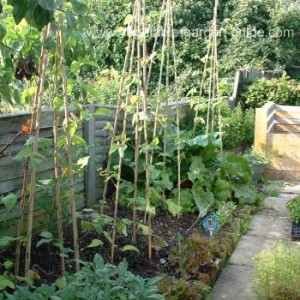Runner Beans Have Stopped Growing
 Question from Ramon:
Question from Ramon:
Hi Pat, I planted my green bean seeds in early May. They sprouted in the first 2 weeks and seemed to be growing just fine. At the end of June it seemed like they just stopped growing, with the biggest plants only 6 inches tall. I live in Riverside Ca. and the weather is pretty hot. They are in full sun most of the day and I water them daily. Why did they stop growing… help!
Answer from Pat:
First, bush beans only grow six or eight inches high. If that is what you planted you don’t have a problem as long as they bear a crop. But read on and see if any of the information below sounds similar to the situation you are facing.
Wendy thought the beans were afflicted with nematodes, but the foliage was deformed and had turned purple and magenta, which is usually a sign of potassium or phosphorus deficiency and not of nematodes. Also, the roots had rotted away leaving a thickened woody root that look more as it were afflicted with Club Root (a disease of the cabbage family.) Wilted foliage is as sign of plants that are attacked by nematodes and also the roots of these beans were club-like and the feeder roots were rotted, which did not look like nematodes. With root damage from nematodes, when you pull up the roots, they usually all hang together and they are often dried out, deformed and twisted with bumps and knobs on them.
I phoned Wendy the next day and suggested she do a soil test since her problem was more likely some kind of rot or it might result from an insufficiency of a nutrient. A soil test could tell us that, so might as well begin there. Wendy purchase an excellent soil kit that contained several little bottles. Using this kit she tested the soil, and the problem turned out to be an insufficiency of nitrogen.
Now I should say right here that beans generally do not need nitrogen since they are legumes and thus can get nitrogen directly from the air, but it is always good to inoculate the seed with the appropriate rhizobia bacterial inoculant when planting beans so that their ability to make their own nitrogen is enhanced. (See page 137 in my book.) But when and if the soil has a serious deficiency perhaps then one needs to add nitrogen, even if it’s breaking the rule for beans. A soil deficiency in nitrogen could happen if un-rotted woody material is in the soil, as might have happened either from insufficiently rotted compost or from un-nitrolized wood shavings in the potting soil. (Some brands of potting soil do not contain enough nitrogen to offset the woody mulch that is in them and if not compensated for, the woody ingredients will rob nitrogen from the soil in order to rot.) I suggest you test your soil to see if it is deficient in any specific nutrient and if it is then provide that nutrient.
With beans growing along the coast, unseasonal cold nights this year have caused problems. Have the nights been cold where you live? Beans are a warm-weather plant and our weather has been more like winter in some areas, but probably not in yours. Cold can seriously damage the growth rate of beans and can turn the foliage yellow because nitrogen is less active in cold temperatures. In England where gardeners often have this problem with green beans they sometimes grow scarlet runner beans instead, since they are more cold-hardy. If you pick scarlet runners very young they taste fine.
For you, who live in a hot interior zone, I would not recommend planting beans so late as May. A better date for beginning is March. Plant beans in March and give them winter protection at first, then they should be up and growing well and bearing beans much earlier than now in July. Once daytime temperatures reach 90 degrees Fahrenheit, this is too hot for beans because the pollen will be no longer be active. Thus beans will stop bearing about one week after this daytime temperature is reached. Also, beans that are planted earlier will be less afflicted by rust problems.

